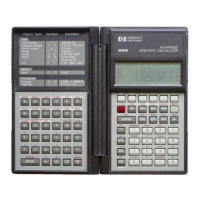Expressions as Functions. In
chapter
4 you created
the
expression
RTOT
and,
using
the
Solver, assigned values to
the
variables
and
then
evaluated RTOT to calculate
the
desired result. In this case
the
expression acted as a
function
which,
given
the
input
values,
produced
a result.
Expressions as Implicit Equations. In
chapter
8 you
used
the
Solver to find
the
numerical zero of
an
expression-that
is,
the
numerical value
of
the
independent
variable for
which
the
expression
has
value
O.
In
chapter
9 you
used
QUAD
to find a symbolic
zero-
that
is,
an
expression
which,
substituted
for
the
independent
variable,
would give
the
original expression
the
value
O.
In
both
cases
the
expression f(x) acts like
the
equation
f(x) =
0,
because
the
zero
of
the
expression is
the
same
as
the
root
of
the
equation.
Equations
Equations
comprise two expressions related
by
an
equals sign
(=).
In
mathematics
there
are two uses for
the
equals sign:
•
To
indicate a proposition,
such
as u
x
2 = 4
U
or
u
x
2 +
y2
=
1.
u
Here
the
equation
holds
only for
some
values
of
the
variables .
•
To
indicate
an
identity
or
definition,
such
as usin 2x = 2
sin
x cos
XU
or
u
y
= 3x
2
+ 2x + 5."
Here
the
equation
holds
for all values
of
the
variables.
On
the
HP-28S,
equations
are
used
for
propositions
only; to
make
a
definition
such
as
fly
=
3x
2
+ 2x + 5,"
the
expression
'3l>::·····2+2l>::+5'
is stored
in
a variable
named
Y.
In "Time Value of Money"
on
page
103,
both
TVM
and
SPPV
are
expressed
mathematically
as equations.
The
TVM
equation,
which
holds
only for
certain
values
of
its variables,
is
entered
as
an
equation;
but
SPPV,
whose
value is
defined
by
the
value
of
its variables, is
created as a variable.
162
16:
Objects

